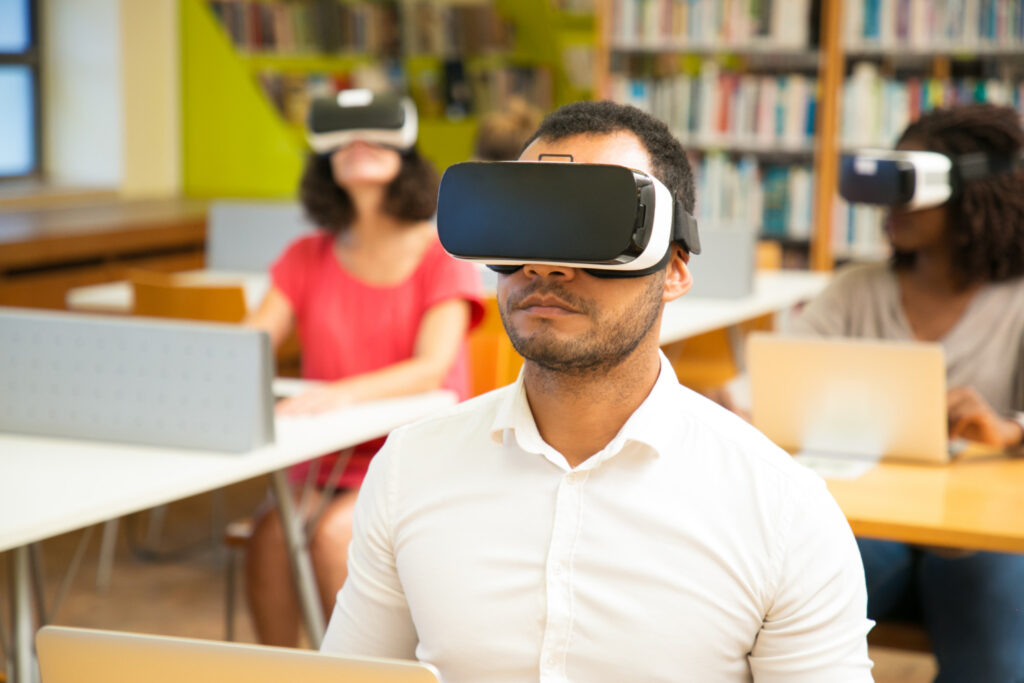In recent years, extended reality (XR) has emerged as a groundbreaking technology, revolutionizing various industries, and education is no exception. Higher education institutions are increasingly leveraging XR technologies, including virtual reality (VR), augmented reality (AR), and mixed reality (MR), to create immersive learning environments. This adoption marks a pivotal shift in how knowledge is delivered and experienced, enabling students to gain deeper insights and practical skills like never before.

What is Extended Reality (XR) and Its Role in Education?
Extended reality serves as an umbrella term for immersive technologies that merge the physical and digital worlds. In higher education, XR facilitates experiential learning, empowering students to interact with complex concepts and scenarios in a safe, controlled environment. This approach transforms traditional methods, making education more engaging, effective, and accessible.
- Virtual Reality (VR): Offers fully immersive environments, enabling students to explore virtual worlds and perform simulated tasks.
- Augmented Reality (AR): Enhances real-world environments by overlaying digital content, such as 3D models and interactive data.
- Mixed Reality (MR): Combines AR and VR to blend virtual and physical elements in real time, fostering collaborative and interactive learning.
How XR Enhances Learning Outcomes
1. Immersive Learning Experiences
XR provides students with hands-on experiences that are difficult to replicate in traditional classrooms. For instance, medical students can practice surgeries in a VR environment, engineering students can test complex designs using AR, and history students can virtually tour ancient civilizations.
2. Bridging the Gap Between Theory and Practice
Extended reality enables students to apply theoretical knowledge in simulated, real-world scenarios. This experiential learning approach enhances retention and develops critical thinking and problem-solving skills.
3. Personalization in Education
XR allows educators to tailor learning experiences to individual needs. Adaptive XR platforms can modify difficulty levels and provide real-time feedback, ensuring that every student progresses at their own pace.
4. Collaboration and Global Connectivity
With XR, students from different geographical locations can collaborate in shared virtual environments. This fosters teamwork, cultural exchange, and the ability to work effectively in diverse settings—essential skills for the global workforce.
Applications of XR in Higher Education
Medical and Healthcare Training
In medical schools, XR simulates real-life medical procedures, helping students master surgical techniques and emergency response protocols. For example, VR-based simulations enable aspiring doctors to practice without risking patient safety, while AR applications assist in anatomy studies by overlaying 3D organs onto physical models.

Engineering and Architecture
Engineering and architecture students benefit from XR by visualizing and testing designs in a virtual space. They can analyze structures, experiment with materials, and understand engineering principles through interactive simulations.
Business and Management Studies
XR immerses business students in scenarios such as virtual boardroom meetings, negotiation exercises, and market simulations. This hands-on approach helps develop leadership, communication, and decision-making skills.
Arts and Humanities
Creative disciplines, including arts, history, and literature, use XR to bring imagination to life. Students can interact with 3D replicas of ancient artifacts, walk through virtual museums, or visualize literary worlds, enhancing their understanding and creativity.
STEM Education
In science, technology, engineering, and mathematics (STEM), XR offers dynamic, interactive content that makes abstract concepts tangible. Chemistry students can safely conduct virtual experiments, while physics students can manipulate variables in simulated environments to observe outcomes.
Challenges in Adopting XR in Higher Education
While the benefits are undeniable, integrating XR into higher education comes with its challenges:
- High Costs: XR hardware, software, and content development require significant financial investment, which may be prohibitive for some institutions.
- Technical Barriers: Implementing XR technologies demands robust infrastructure, skilled personnel, and ongoing maintenance.
- Access and Equity Issues: Ensuring equal access to XR tools for all students, including those from underprivileged backgrounds, is a critical concern.
- Content Development: Creating high-quality, subject-specific XR content requires collaboration between educators, developers, and industry experts.
The Future of XR in Higher Education
As XR technologies continue to evolve, their integration into higher education will become more seamless and impactful. Advances in artificial intelligence (AI), cloud computing, and 5G connectivity will enhance XR’s capabilities, making it more affordable and accessible. Furthermore, partnerships between universities, tech companies, and government agencies will accelerate the development of innovative XR solutions tailored to educational needs.
Emerging Trends to Watch
- Holographic Classrooms: Real-time holograms of professors teaching in remote locations.
- AI-Powered Personal Tutors: Adaptive XR tools that use AI to provide personalized learning support.
- Wearable XR Devices: Lightweight and affordable headsets enabling mobile learning experiences.

Conclusion
The adoption of extended reality in higher education is not just a technological innovation but a paradigm shift in how we approach teaching and learning. By embracing XR, institutions can equip students with the skills and knowledge needed for a rapidly changing world. Although challenges remain, the transformative potential of XR far outweighs the hurdles, making it an indispensable tool for the future of education.
FAQ’s
What is extended reality (XR)?
Extended reality (XR) is a collective term for immersive technologies that combine real and virtual environments. XR includes virtual reality (VR), augmented reality (AR), and mixed reality (MR), offering enhanced interactive and engaging experiences.
How is XR used in higher education?
In higher education, XR is used for immersive learning experiences such as virtual labs, interactive simulations, and collaborative environments. It enables students to gain practical skills, understand complex concepts, and participate in virtual field trips.
What are the benefits of XR in education?
Key benefits of XR in education include:
Enhanced engagement: Makes learning interactive and fun.
Experiential learning: Bridges the gap between theory and practice.
Personalized education: Tailors content to individual learning needs.
Global collaboration: Allows remote collaboration with peers worldwide.
Which fields benefit the most from XR in higher education?
Fields that benefit greatly from XR include:
Medicine and healthcare: For surgical simulations and anatomy studies.
Engineering and architecture: For visualizing designs and testing prototypes.
Business and management: For market simulations and negotiation exercises.
Arts and humanities: For virtual museums and interactive storytelling.
STEM disciplines: For virtual experiments and scientific modeling.
What are the challenges of adopting XR in higher education?
Challenges include:
High costs of hardware and content development.
Need for robust technical infrastructure and trained staff.
Ensuring equitable access to XR tools for all students.
Developing high-quality, curriculum-relevant content.
Are XR technologies accessible for all institutions?
While XR adoption is growing, smaller institutions may face budgetary and technical barriers. However, as XR hardware becomes more affordable and cloud-based solutions gain traction, access is expected to improve.
What skills can students develop using XR?
Students can develop:
Problem-solving and critical thinking.
Hands-on technical and professional skills.
Collaboration and communication in global, virtual settings.
Creativity and innovation through interactive tools.

